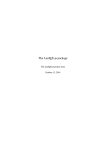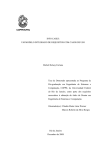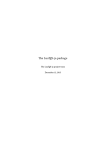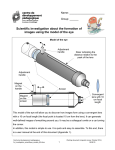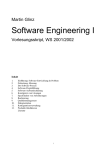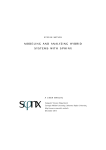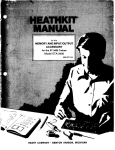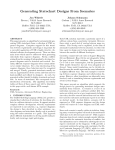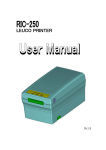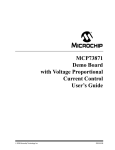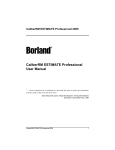Download 04 Debugging - Department of Informatics
Transcript
Department of Informatics!
Martin Glinz
Software Quality
Chapter 4
Debugging
"
© 2014 Martin Glinz. All rights reserved. Making digital or hard copies of all or part of this work for educational, non-commercial use is permitted. Using this material for
any commercial purposes and/or teaching is not permitted without prior, written consent of the author. Note that some images may be copyrighted by third parties."
4.1 "Foundations"
4.2 "The Debugging Process"
4.3 "Reproducing Errors"
4.4 "Simplifying and Automating Test Cases"
4.5 "Techniques for Defect Localization"
4.6 "Defect Fixing"
"
Software Quality
"4. Debugging
"© 2014 Martin Glinz "
2"
Terminology"
Debugging – The process of finding and correcting a defect
that causes an observed error"
Defect (fault) – A faulty element in a program or other artifact"
Error – A deviation of an observed result from the expected /
correct result"
❍
The term bug may denote a defect or an error"
❍
An error may be caused by a combination of multiple
defects "
❍
The very same defect may manifest in more than one error"
„Program“ is meant in a comprehensive way: may be a
single method or a component, or a complete system"
❍
Software Quality
"4. Debugging
"© 2014 Martin Glinz "
3"
Causes and Effects"
❍
Typically, a defect "
●
●
●
●
❍
does not immediately lead to an error that can be observed,"
but to faulty program states,"
that propagate"
and eventually manifest as observable errors"
The main task of debugging is identifying / reconstructing
the cause-effect chain from a defect to an observable error"
Software Quality
"4. Debugging
"© 2014 Martin Glinz "
4"
Where defects occur"
❍
Classic: defect is a coding error, caused by a human
mistake"
❍
Alternatively:"
●
●
●
●
❍
Defects in other artifacts: requirements specification, system
architecture, system design, user manual, ..."
Defects in the data"
Defects in processes"
Human mistakes when using or operating a system"
Some defects are not local, but affect a complete system or
sub-system"
Software Quality
"4. Debugging
"© 2014 Martin Glinz "
5"
Example: A simple sorting problem"
[Zeller 2005]"
Name: sample"
Author: Andreas Zeller"
Language: C"
Call: ./sample arg1 arg2 ... argn"
Precondition: arg1 arg2 ... argn are integers, n ∈ IN"
Postcondition: The arguments appear in ascending order on
the standard output device"
Executing sample with test data:"
$ ./sample 9 7 8!
$ ./sample 11 14!
Output: 0 11!
Output: 7 8 9!
$ _!
$ _!
Software Quality
"4. Debugging
"© 2014 Martin Glinz "
6"
Program sample: The code"
/* sample.c -- Sample C program to be debugged */!
!
#include <stdio.h>!
#include <stdlib.h>!
!
static void shell_sort(int a[], int size)!
{!
int i, j;!
int h = 1;!
!
do {!
h = h * 3 + 1;!
} while (h <= size);!
do {!
h /= 3;!
for (i = h; i < size; i++)!
{!
int v = a[i];!
for (j = i; j >= h && a[j - h] > v; j -= h)!
a[j] = a[j - h];!
if (i != j)!
a[j] = v;!
}!
} while (h != 1);!
}!
Software Quality
"4. Debugging
"© 2014 Martin Glinz "
7"
Program sample: The code – 2"
!
int main(int argc, char *argv[])!
{!
int *a;!
int i;!
!
a = (int *)malloc((argc - 1) * sizeof(int));!
for (i = 0; i < argc - 1; i++)!
a[i] = atoi(argv[i + 1]);!
!
shell_sort(a, argc);!
!
printf("Output: ");!
for (i = 0; i < argc - 1; i++)!
printf("%d ", a[i]);!
printf("\n");!
!
free(a);!
!
return 0;!
}"
Software Quality
"4. Debugging
"© 2014 Martin Glinz "
8"
What now?"
Observation:"
There are input data, for which sample computes a wrong
result"
Question:"
❍
How do we find the defect in the code that causes this
error?"
❍
Is there a way of systematically searching for a defect?"
Software Quality
"4. Debugging
"© 2014 Martin Glinz "
9"
4.1 "Foundations"
4.2 "The Debugging Process"
4.3 "Reproducing Errors"
4.4 "Simplifying and Automating Test Cases"
4.5 "Techniques for Defect Localization"
4.6 "Defect Fixing"
"
Software Quality
"4. Debugging
"© 2014 Martin Glinz "
10"
The main steps of the debugging process"
❍
Describe the problem precisely"
●
❍
Sometimes this alone reveals the source of the problem"
Is the problem a software error?
If yes: "
●
Perform classic debugging"
"If no:"
●
❍
Search and fix the problem elsewhere, e.g."
• Defects in user manuals"
• Faulty business processes"
• Training deficits"
Check the effectiveness of the fix"
Software Quality
"4. Debugging
"© 2014 Martin Glinz "
11"
The classic software debugging process"
❍
Reproduce the error"
❍
Simplify and (if possible) automate the test case that
produces the error"
❍
Localize the defect that causes the error"
●
●
●
●
❍
Create and test hypotheses"
Observe program states"
Check the validity of assertions in the program"
Isolate cause-effect chains"
Fix the identified defect(s)"
Software Quality
"4. Debugging
"© 2014 Martin Glinz "
12"
Checking the effectiveness of the fix"
❍
Make sure that the defect has been fixed:"
●
●
❍
Re-run the test case(s) that resulted in errors"
Everything ok now?"
Make sure that the fix did not create any new defects"
●
●
Run your regression test suite"
No new problems found?"
Software Quality
"4. Debugging
"© 2014 Martin Glinz "
13"
Required infrastructure"
❍
Problem reporting infrastructure"
●
●
❍
Process for handling problem reports"
Tool for problem report administration and tracking
For example, Bugzilla"
Configuration management system for software artifacts"
Software Quality
"4. Debugging
"© 2014 Martin Glinz "
14"
4.1 "Foundations"
4.2 "The Debugging Process"
4.3 "Reproducing Errors"
4.4 "Simplifying and Automating Test Cases"
4.5 "Techniques for Defect Localization"
4.6 "Defect Fixing"
"
Software Quality
"4. Debugging
"© 2014 Martin Glinz "
15"
A sample bug report"
Example: "Mozilla bug report no. 24735 from 1999"
->
->
->
->
Start mozilla
Go to bugzilla.mozilla.org
Select search for bug
Print to file setting the bottom and right margins to .50
(I use the file /var/tmp/netscape.ps)
-> Once it's done printing do the exact same thing again on
the same file (/var/tmp/netscape.ps)
-> This causes the browser to crash with a segfault
[Zeller 2005, p. 55]"
Goal: Create an as simple as possible test case that
reproduces the reported problem"
Software Quality
"4. Debugging
"© 2014 Martin Glinz "
16"
Typical problems "
❍
Reproducing the environment in which the problem occurs"
❍
Reproducing the history trail may be necessary"
❍
For software errors: reproduce a program run that causes
the error; this may include"
●
●
●
●
●
●
●
Input data"
Initial persistent data"
User interaction, interaction with neighboring systems"
Time"
Communication with other processes"
Process threads"
Random data"
Software Quality
"4. Debugging
"© 2014 Martin Glinz "
17"
Time-dependent errors: a case "
In early 1992 a company installed a new barrier gate control
system in a couple of parking garages. In the morning of
September 12, 1992, the operators of all these garages called
the support line and reported the same problem: the exit
barriers didn’t open anymore."
What caused this problem?"
The date had been coded with two integers, one for the year
and one for the day of the year."
Unfortunately, the programmer had chosen the type short int
(i.e., one byte) for both variables. September 12 was day 256
in that year..."
Software Quality
"4. Debugging
"© 2014 Martin Glinz "
18"
4.1 "Foundations"
4.2 "The Debugging Process"
4.3 "Reproducing Errors"
4.4 "Simplifying and Automating Test Cases"
4.5 "Techniques for Defect Localization"
4.6 "Defect Fixing"
"
Software Quality
"4. Debugging
"© 2014 Martin Glinz "
19"
Simplifying"
❍
Given: a test case which reliably causes a reported error"
❍
Goal:"
●
●
Remove all irrelevant parts of the test case"
Automate the simplified test case"
❍
In an optimally simplified test case, all constituents are
relevant, i.e. removing anything from the case no longer
produces the reported error"
❍
How to simplify?"
●
●
●
Simplify environment"
Reduce history trail"
Simplify inputs / interactions"
Software Quality
"4. Debugging
"© 2014 Martin Glinz "
20"
Automating"
❍
The error-provoking test case must be executed frequently
in the debugging process:"
●
●
for finding simplifications"
for testing hypotheses when systematically locating a defect"
➪ Automation pays off"
❍
Test automation techniques: → Chapter 4 of this course"
Software Quality
"4. Debugging
"© 2014 Martin Glinz "
21"
Simplify the environment"
❍
Determine which states or conditions in the system’s
environment are relevant and which ones aren’t"
●
●
●
●
Hardware and operating system"
State of persistent data"
Time"
State of neighboring systems"
❍
Irrelevant states and conditions can be safely ignored"
❍
Goal: minimize the effort for setting up the test environment
in which the a test case produces the reported error"
❍
Means: systematic trying"
Software Quality
"4. Debugging
"© 2014 Martin Glinz "
22"
Simplify the error history"
❍
Can we reduce the number of steps, required for provoking
the error?"
❍
Means: systematic trying"
❍
Example: Mozilla bug report no. 24735 (see above) reports
the following error-provoking sequence of steps:
Start mozilla; Go to bugzilla.mozilla.org; Select search for bug; Print to
file setting the bottom and right margins to .50; Once it's done printing
do the exact same thing again on the same file.
"Actually, the following steps suffice to provoke the error:
Start mozilla; Go to bugzilla.mozilla.org; Select search for bug; Press
Alt-P; Left-click on the Print button in the print dialog window."
Software Quality
"4. Debugging
"© 2014 Martin Glinz "
23"
Simplify inputs"
❍
Example: Mozilla bug report no. 24735 (see above)"
●
●
The erroneous printing function uses the currently displayed
web page as input"
This page consists of 896 lines of html code"
❍
Which parts of this data cause the error and which ones
are irrelevant?"
❍
Means: binary search [Kernighan and Pike 1999]"
●
●
●
Partition the set of input data into two halves"
Test both halves individually"
Recursively continue with that half which provokes the error"
Software Quality
"4. Debugging
"© 2014 Martin Glinz "
24"
Simplify inputs – 2: An example"
[Zeller 2005]"
❍
Example: Mozilla bug report no. 24735 (see above)"
❍
Binary search yields a single fault-provoking line of html
code in twelve steps:"
1"
2"
3"
4"
5"
6"
..."
12
Software Quality
"<SELECT NAME="priority" MULTIPLE SIZE=7>
"4. Debugging
"© 2014 Martin Glinz "
896 lines"
448 lines"
224 lines"
112 lines"
112 lines"
56 lines"
"
1 lines"
✘
✘
✘
✔
✘
✘
✘
25"
Simplify inputs – 3"
❍
What to do if both halves don’t provoke the error while the
whole does?"
<SELECT NAME="priority" MULTIPLE SIZE=7>" ✘
<SELECT NAME="priority" MULTIPLE SIZE=7>" ✔
<SELECT NAME="priority" MULTIPLE SIZE=7>" ✔
❍
Instead of halves use smaller portions, e.g., quarters"
<SELECT NAME="priority" MULTIPLE SIZE=7>"
<SELECT NAME="priority" MULTIPLE SIZE=7>"
☞" <SELECT NAME="priority" MULTIPLE SIZE=7>"
<SELECT NAME="priority" MULTIPLE SIZE=7>"
❍
Continue with eighths, etc."
❍
Result:"
Software Quality
<SELECT> "
"4. Debugging
"© 2014 Martin Glinz "
✔
✘
✘
✔
✘
26"
Automating the simplification"
❍
Simplification can be automated partially"
●
●
❍
In particular, the technique of binary searching"
Applicable for simplification of input data or interaction
sequences"
Example: Zeller’s ddmin delta debugging algorithm
[Zeller 2005, Chapter 5.4-5.5]"
Software Quality
"4. Debugging
"© 2014 Martin Glinz "
27"
Another example"
Microsoft PowerPoint 2004 Version 11.0 on MacBook Pro
with Mac OS 10.5.6 crashed during startup if the font Hiragino
Kaku Gothic Pro was disabled in the font collection."
"
Using interval bisection on
the set of all fonts we can
find a minimal set of
deactivated fonts that
causes the error. This set
only contains the font
Hiragino Kaku Gothic Pro."
Software Quality
"4. Debugging
"© 2014 Martin Glinz "
28"
4.1 "Foundations"
4.2 "The Debugging Process"
4.3 "Reproducing Errors"
4.4 "Simplifying and Automating Test Cases"
4.5 "Techniques for Defect Localization"
4.6 "Defect Fixing"
"
Software Quality
"4. Debugging
"© 2014 Martin Glinz "
29"
Overview ""
❍
Create and test hypotheses"
❍
Static and dynamic program analysis"
●
●
Control flow"
Data flow"
❍
Analyze program states"
❍
Observe program execution (stepping, breakpointing)"
❍
Dynamically check program assertions"
❍
Determine and isolate cause-effect chains"
❍
Debugging by “gut feeling”"
Software Quality
"4. Debugging
"© 2014 Martin Glinz "
30"
Creating and testing hypotheses"
❍
The basis of systematic debugging"
❍
Principle: Get insight through theory and experimentation"
1."Create a hypothesis"
2. Derive predictions from hypotheses"
3."Verify predictions experimentally"
4. If predictions and experiment results match"
• Correctness of hypothesis becomes more probable"
Theory"
• Try to further confirm hypothesis"
"Otherwise:"
• Reject hypothesis"
• Create new or modified hypothesis; continue with step 2"
❍
Important: record the track of all tested hypotheses"
Software Quality
"4. Debugging
"© 2014 Martin Glinz "
31"
Finding hypotheses"
Possible ways:"
❍
Analysis of problem description"
❍
Static analysis of the code"
❍
Analysis of a erroneous execution run"
❍
Comparison of correct and erroneous execution runs"
❍
Building new hypotheses on the basis of previous ones:"
●
●
Must be compatible with previously accepted"
Must not use assumptions that stem from previously rejected
hypotheses"
Software Quality
"4. Debugging
"© 2014 Martin Glinz "
32"
Derive and check predictions"
❍
Techniques"
●
●
●
❍
Deductive approach: draw logical conclusions from"
●
●
●
❍
Static or dynamic analysis of the code"
Observation of system states"
Dynamic checking of assertions"
existing knowledge"
the source code"
test cases and test results"
Experimental approach: observe"
●
●
program execution"
program state"
Software Quality
"4. Debugging
"© 2014 Martin Glinz "
33"
Example: Program sample (cf. 4.1)"
❍
First hypothesis"
Program runs correctly!
Prediction: Entering 11 14 yields 11 14 as result"
Experiment: $!./sample 11 14!
!! ! ! ! Output: 0 11 ! ! !✘!
➥ Hypothesis is rejected"
Software Quality
"4. Debugging
"© 2014 Martin Glinz "
34"
Example: Program sample (cf. 4.1)"
❍
Second hypothesis"
Program prints wrong variables!
Prediction: "a[0]==11, a[1]==14, but result is"
!! ! ! ! !Output: 0 11 "
Experiment: Replace code for input and sorting by "
a[0] = 11; a[1] = 14; argc = 3;!
Result: " " Output: 11 14 ! ! !✔!
➥ Hypothesis is rejected"
Software Quality
"4. Debugging
"© 2014 Martin Glinz "
35"
Static and dynamic analysis"
❍
Analyzing the control flow and the data flow of a program
(see Chapter 3 on data flow testing and Chapter 12 of my Software
Engineering course)"
❍
Static Analysis"
●
●
●
❍
Yields the potentially possible control and data flows"
No program execution required"
Independent of any concrete test cases"
Dynamic Analysis"
●
●
Analyzes a concrete program run (based on a test case)"
Yields actual control and data flows for this run"
Software Quality
"4. Debugging
"© 2014 Martin Glinz "
36"
Example: static vs. dynamic program slicing"
int main() {!
int a, b, sum, mul;!
sum = 0;!
mul = 1;!
a = read ();!
b = read ();!
while (a<=b) {!
sum = sum + a;!
mul = mul * a;!
a = a +1;!
}!
write (sum);!
write (mul);!
}!
Sample program"
Software Quality
"4. Debugging
int main() {!
int a, b, sum, mul;!
sum = 0;!
mul = 1;!
a = read ();!
b = read ();!
while (a<=b) {!
sum = sum + a;!
mul = mul * a;!
a = a +1;!
}!
write (sum);!
write (mul);!
}!
Static slice of mul in
line 13"
"© 2014 Martin Glinz "
int main() {!
int a, b, sum, mul;!
sum = 0;!
mul = 1;!
a = read ();!
b = read ();!
while (a<=b) {!
sum = sum + a;!
mul = mul * a;!
a = a +1;!
}!
write (sum);!
write (mul);!
}!
Dynamic slice of mul in line 13 with a=5, b=2"
37"
Analysis of program states"
❍
The problem: a defect typically"
●
●
❍
leads to a sequence of erroneous states"
that eventually manifest in observable errors"
Check suspicious program states"
●
Instrumentation of the code:"
• Record variable values"
• Print or log variable values, maybe using a logging framework
such as LOG4J [Logging Services]"
●
Using a debugger"
• Compile program in debug mode"
• Halt execution at critical points (by setting breakpoints)"
• Inspect current variable values"
Software Quality
"4. Debugging
"© 2014 Martin Glinz "
38"
Example: Program sample (cf. 4.1)"
❍
Third hypothesis"
Sorting procedure called with wrong parameters!
Prediction: "Values in array a and/or value of argc wrong"
Experiment: "Prior to the call of shell_sort we instrument the "
"source code with"
!printf("Parameters of shell_sort: ");!
!for (i = 0; i <= argc; i++)!
! printf("%d ", a[i]);!
!printf ("%d ", argc);!
!printf("\n");!
✘!
Result:
"Parameters of shell_sort: 11 14 0 3
➥ Hypothesis is confirmed"
❍
Alternatively, we could have used a debugger"
Software Quality
"4. Debugging
"© 2014 Martin Glinz "
39"
Observe program execution"
Using a debugger, we can"
❍
Stepwise execute a program or halt it at breakpoints"
●
●
❍
Compare expected and actual control flow"
Inspect parts of system state where appropriate"
Observe variable definition, modification and use"
"
Software Quality
"4. Debugging
"© 2014 Martin Glinz "
40"
Checking assertions"
❍
Specifying contracts for classes and methods with
assertions:"
●
●
●
Preconditions"
Postconditions"
Invariants"
"Formally specified contracts can be checked dynamically
by a suitable runtime system"
❍
When an assertion is violated, analyze the program state"
Software Quality
"4. Debugging
"© 2014 Martin Glinz "
41"
Causes and effects"
❍
An observation:"
●
❍
Question:"
●
❍
In the decade of 1950 to1960 the decline of the population of
storks in Europe is strongly correlated with the increasing
number of tarmac roads"
Is the increasing number of tarmac roads the / a cause for
the disappearance of storks?"
Testing for causality: a is a cause for b iff"
●
●
●
b occurs if a has occurred previously"
b does not occur if a has not occurred previously"
All other variables are kept constant"
Software Quality
"4. Debugging
"© 2014 Martin Glinz "
42"
Causes and effects – 2"
❍
Experimental proof of (or evidence for) causality"
●
●
❍
In debugging, a cause for an error f can be viewed as the
difference between"
●
●
❍
Generally rather difficult: Problem of controlled experiments"
For debugging, it is doable: "
• Controlled environment"
• Test case reproducible"
a test case exhibiting the error f" " "(1)"
a test case that runs correctly " " "(2)"
Again, we look for a minimal cause"
➥ Search a minimal difference between (1) and (2)"
Software Quality
"4. Debugging
"© 2014 Martin Glinz "
43"
Example: Program sample (cf. 4.1)"
❍
Fourth hypothesis"
shell_sort should be called with argc-1 (instead of argc)!
Prediction: "Result is correct"
Experiment: "Execute with modified source code (or modify
state of running program with a debugger)"
Result:
"Output: 11 14 !✔!
➥ Hypothesis is confirmed"
❍
From the first hypothesis we know that calling shell_sort
with argc leads to an error"
❍
The difference in the code is „-1“ in line 36"
❍
This is a minimal cause of the error"
Software Quality
"4. Debugging
"© 2014 Martin Glinz "
44"
Identifying and isolating cause-effect chains"
❍
The immediate cause of an error normally is not a defect,
but an erroneous program state, eventually caused by a
defect"
●
●
Identify cause-effect chains"
and isolate them from the irrelevant rest of the program"
❍
Time-consuming: Requires creation and test of many
hypotheses"
❍
Systematic procedure needed"
❍
Automatable: Zeller’s Delta Debugging algorithm [Zeller
2002] "
Software Quality
"4. Debugging
"© 2014 Martin Glinz "
45"
Isolating causes with Delta Debugging"
❍
Difference between isolation and simplification:"
●
●
❍
Simplification: Find a minimal error-provoking test case"
Isolation: Find an error-provoking and an error-free test case
with a minimal difference"
Example: Isolation of minimal error cause in this input:"
" "
Minimal difference = minimal cause"
Error-provoking:
Error-free:
Software Quality
"4. Debugging
"5;6;2:1;
"✘
"5;6;2:1;
"✔
"5;6;2:1;
"✔
"5;6;2:1;
"✔
"Ø (empty input)
"✔ ""
"© 2014 Martin Glinz "
Reduce erroneous
case"
Extend error-free
case"
46"
Debugging by gut feeling"
❍
To some extent, experienced software engineers develop
an ability to “smell” the cause of an error"
❍
In many cases, debugging by intuition is faster than any
systematic debugging procedure"
❍
Problem: "
●
●
❍
We need to stop intuitive debugging at the right time when it
does not succeed..."
...and then switch to systematic debugging"
Suggested procedure"
●
●
For a strictly limited time, debug by intuition"
If success: Eureka! else: stop and start systematic debugging"
Software Quality
"4. Debugging
"© 2014 Martin Glinz "
47"
4.1 "Foundations"
4.2 "The Debugging Process"
4.3 "Reproducing Errors"
4.4 "Simplifying and Automating Test Cases"
4.5 "Techniques for Defect Localization"
4.6 "Defect Fixing"
"
Software Quality
"4. Debugging
"© 2014 Martin Glinz "
48"
Fixing a localized defect"
If a defect has been located"
❍
Estimate severity of defect"
❍
Determine what and how much has to be fixed"
❍
Estimate impact on other parts of the system"
❍
Make the required modifications to the code and/or the
documentation carefully and systematically"
❍
Avoid quick-and-dirty patching of code "
Software Quality
"4. Debugging
"© 2014 Martin Glinz "
49"
Check effectiveness of problem resolution"
❍
Make sure that the reported problem no longer exists
In case of software errors:"
●
●
❍
Check for unexpected side effects"
●
●
❍
Inspect the modified code and documentation "
Test the modified units"
• using the error-provoking test case(s)"
• by writing more unit test cases"
Adapt the regression test suite to the modified code "
Perform a regression test"
Create a new configuration / release"
Software Quality
"4. Debugging
"© 2014 Martin Glinz "
50"
Learning from the fixed defect"
Defects are typically due to mistakes by humans"
❍
Try to determine / guess the reasons why somebody made
the mistake(s) that led to the defect"
❍
Investigate if there are any similar defects in the source
code that stem from the same kind of mistake"
❍
Are there any constructive means to avoid such defects in
the future, e.g., by"
●
●
changing a process"
training people"
Software Quality
"4. Debugging
"© 2014 Martin Glinz "
51"
References"
S.C. McConnell (1993). Code Complete: A Practical Handbook of Software Construction. Redmond:
Microsoft Press."
B.W. Kernighan, R. Pike (1999). The Practice of Programming. Reading, Mass.: Addison-Wesley."
M. Weiser (1992). Programmers Use Slices When Debugging. Communications of the ACM 25(7):446–
452."
A. Zeller (2002). Isolating Cause-Effect Chains from Computer Programs. Proceedings of the 10th ACM
SIGSOFT Symposium on the Foundations of Software Engineering. Charleston, South Carolina.1–10."
A. Zeller (2005). Why Programs Fail: A Guide to Systematic Debugging. Amsterdam: Morgan Kaufmann
and Heidelberg: dpunkt."
"
Bugzilla. http://www.bugzilla.org"
Logging Services. http://logging.apache.org"
"
"
"
"
Software Quality
"4. Debugging
"© 2014 Martin Glinz "
52"




















































